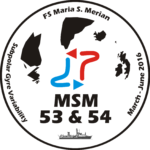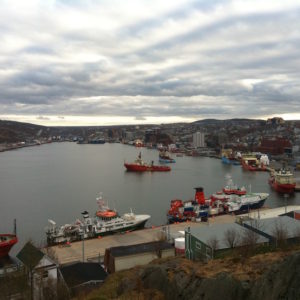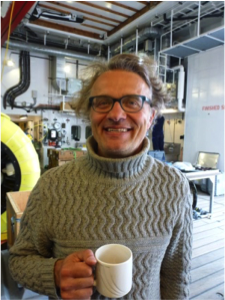by Johannes Karstensen, chiefscientist MSM54 expedition
The ocean-class German research ships are rarely seen in Germany. They follow a route that is composed by many individual expeditions and converting the ships travel into a long, long journey; for Maria S Merian this journey takes place primarily in the North Atlantic and it transition into the Arctic Ocean. As a consequence – the scientists have to travel to where the ship is and have to bring with them (again by ship, but container ships) the equipment that is needed for the experiments to be performed at sea.
Without equipment brought by the scientists the Maria S Merian is not at all an empty ship – she carries a lot of equipment, required by almost all groups that make use of the ship, such as cranes, work shops, communication devices, instrumentation. However, most important – the ship is manned with a skilled, experienced and simply great crew, providing all support to not only conduct experiments at sea but to find a comfortable atmosphere which makes life at sea easy for us, the non-seamen.
In the last ten years I have been six times to St. Johns, Canada – all times to enter a ship (two times the Maria S Merian) for expeditions to the Labrador Sea. Typically I arrive 3 to 4 days before the cruise starts, just to be here when the ship arrives and to help loading and setting up equipment. The arrival of the ship is always special; for example people often eagerly wait to be back to shore, leaving the steadily moving platform behind – but to discover that the movement continues even on land for the next couple of days. St. Johns is a convenient harbour for us, just 1.5 days transit to one of our main working areas (the “53°N array”) – but it is also a nice little town settled around a large natural harbour bay.

Caption: View from Battery Park on St. Johns harbour. The two research ships (easy to identify by the “A” formed crane mounted at the stern, are the Irish Celtic Explorer (keft) and the German Maria S. Merian (right). credit: J. Karstensen
We, a science crew of 20 people, need for the installations and experiments planned during this trip (called MSM54) an amount of material that came in 7 containers. We fixed 4 containers to the ships deck but the rest of the material is now distributed in the labs.
The science crew is composed of five people from Canada’s Dalhousie University, one person from Duke University in the US, and 14 persons from GEOMAR in Germany. We are a mix of students (9), from PhD to BSc, technicians (7), and full scientists (4). A lot of the work that will be done is very technical – installing quite heavy equipment that ultimately serves us to conduct our experiments at sea generating data that is of use for our scientific investigations. What we are really after is to better understand how our ocean regulates climate – for example by taking up heat and other substances in specific regions, such as the Labrador Sea, where large amounts of near surface water sink to sometime deeper than 2000m depth, and from where it spreads far into the ocean interior.
What regulates the sinking process and how does the water spread in the ocean interior are some of the questions we want to answer. The 53°N-Array has been first installed in 1997, long before I came to Kiel to work in this region. It is a unique time series not only because it is operational since so long, but because it has been well designed from the beginning. Setting up a time series has similarities in buying a house – the only thing that matters is the location!
On this trip we will recovery many instruments that were installed during the last service of the array in 2014. For that cruise we started, guess where? – in St. Johns, correct! but on the French Research Vessel NO Thalassa. Not only the two of us who participated in the Thalassa expedition are now very excited to see how well the instrumentation had worked over the last two years. In 2018 we plan to come to the Labrador Sea again to service the “53°N-Array” – and I hope I can one more time join the long, long journey of the RV Maria S Merian.

Credit: C. Schmidt